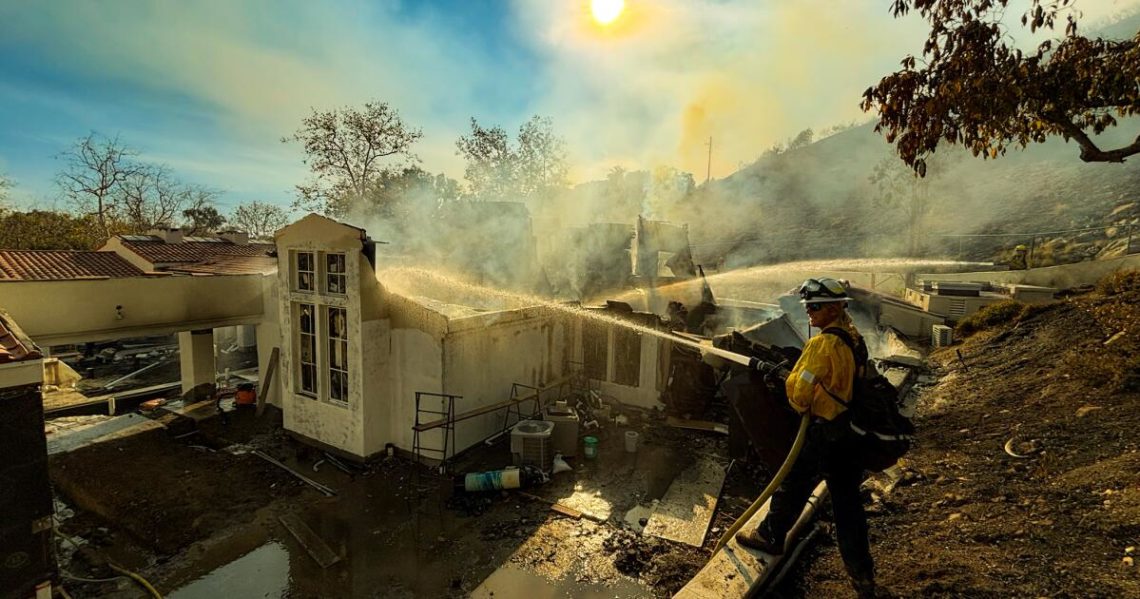When a column of smoke rose above Pacific Palisades on January 7, a couple dozen residents of the Santa Monica Mountains, instead of evacuating, jumped into their own fire engines. The Community Brigade raced door to door ordering residents to evacuate, stamped out spot fires and transported animals (including koi fish) to safety.
As the fire garnered national attention, Keegan Gibbs, the brigade’s director of operations, found himself talking to CNN, Vogue and the New York Times. Locals, galvanized by the events of January, began signing up in droves. The team of about 50 received hundreds of requests to join.
Starting Saturday, the brigade, which has operated formally under the supervision of the Los Angeles County Fire Department since 2023, will begin training roughly 50 new recruits in a classroom they’ve co-opted at Pepperdine University — essentially doubling the brigade’s size. They hope to double it again next year.
Gibbs views the brigade’s high-profile firefighting as a “Trojan horse” to recruit citizens to help with the “real work” — home hardening and community wildfire preparedness. Yet some fire safety advocates argue there’s simply no need to engage in dramatic, high-risk operations in order to make a difference.
“There’s plenty that you as concerned citizens can do,” said David Barrett, executive director of the Los Angeles Regional Fire Safe Council (one of the many organizations that does wildfire preparedness work similar to the brigade, just without the firefighting part).
For the brigade, he said, “It’s terrific that you want to protect your community — How would you feel if your actions caused the death of a firefighter? What would happen if your vehicles clogged evacuation routes and people couldn’t get out? What if you forced firefighters to rescue you?”
Guerrilla-style fire brigades have a long history in the Santa Monica Mountains, where the old-school do-it-yourself ethos of ranchers still permeates, Gibbs, a lifelong resident, noted. But the 2018 Woolsey fire, which Gibbs and his longtime friend Tyler Hauptman fought with garden hoses and shovels, stirred a rising frustration among residents that they could not trust the Fire Department alone to save their homes.
So, after nearly five years of negotiations, the County agreed to formalize a brigade. In the agreement, the brigade gained significant access to Fire Department training and the authority to operate in emergency situations. Meanwhile, the Fire Department took meaningful control over the previously haphazard operations — the department could now reject or remove certain individuals from the brigade, dictate its role during emergencies and ensure its activities don’t interfere with professional operations.
It also requires volunteers to acknowledge the significant risks of injury and death by participating in the brigade, and that the Fire Department is not liable if something goes wrong.
The brigade’s leaders say they take safety extremely seriously: They have a rigorous screening process for applicants (including a background check), provide routine professional-grade firefighter training, and have strict limitations on what they can and cannot do during an emergency, acting as background support for the professionals instead of running for the ferocious front line.
“There’s a lot that we don’t do because either it’s too dangerous, we don’t have the equipment for it or we’re not trained for it,” Gibbs said. “We have guardrails. This isn’t an unhinged ‘Hey, just go drive towards the fire.’”
The evening of Jan. 7, as the winds picked up, the power of the Palisades fire became terrifyingly apparent to Gibbs.
One of the crew’s fire engines — a “Type 6,” essentially a decked-out pickup truck — blew a fuse, leaving it stuck in park as a nearby home erupted into flames. The team dispatched another brigade member to attempt to fix it. An hour passed as flames engulfed Pacific Coast Highway, the crew’s way out.
By the time the crew got the truck in working order and made their escape, the dark of night had already set in. Gibbs drove out, with the fires lighting the way and the crackling of the radio keeping him updated. The situation now seemed out of control as fire crews began responding to another fire near Altadena.
In that moment, Gibbs felt a deep sense of responsibility for the lives of his fellow brigade members. “It made you feel fragile or brittle of just how easily something as simple as a fuse could just completely break down your operation,” he said.
It’s this precarious reality that seriously concerns Barrett. Becoming a professional firefighter typically requires hundreds of hours of training. And after that, departments train weekly, with continual medical screenings and re-qualifications.
“The wildfire conditions in California are far too dangerous for moderately trained civilians,” he said.
While the ferocity of the Palisades fire shook both Barrett and the brigade members, Hauptman noticed a silver lining while driving through his town on fire: Many of the homes the brigade had inspected and helped residents harden still stood tall amid the flames.
“One house in particular looked seemingly untouched — but it was up Los Flores Canyon, which saw some of the most extreme fire behavior I’ve ever witnessed,” said Hauptman, now the brigade’s director of mitigation. “That was pretty much all the validation that we really needed to understand how powerful this is, getting homes prepared in our local community, because you can only do so much during an actual incident.”
To date, the brigade has completed over 400 of these inspections, according to Hauptman. The focus is not necessarily on the regulations residents must comply with (although those are important, too) but instead on teaching them how homes burn.
“We imagine we have a big box of matches, and we start lighting them,” Hauptman said. “We’re lighting it around the whole house, the whole perimeter, and seeing what ignites.”
For the brigade, the name of the game is community buy-in. When top-down fire safety requirements — like home hardening, defensible space and evacuation planning — fail, whether due to a lack of enforcement or intense public backlash, slowly building trust with neighbors to help them start thinking about fire differently can go a long way.
It might be a brigade member that convinces their neighbor to evacuate, not a cellphone alert. It might be a brigade member that teaches a resident how to harden their home and clear their brush, not a list of regulations from the state. And it might be a brigade member that convinces a homeowner to pack their stuff during a Red Flag Warning, not a tweet from local officials.
“It’s received in a different way when you’re just hanging out with your friends or in your community talking neighbor to neighbor,” said Gibbs. “They start absorbing some of that in a way that they can’t when it’s said to them from the top down.”
The post The citizen fire brigade that helped fight the Palisades fire is growing. Is it worth the risk? appeared first on Los Angeles Times.




